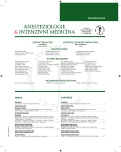A man with painless jaundice, anaemia and intermittent chest pain – case report
Authors:
Karvunidis Thomas; Chvojka Jiří; Ledvinová Lenka; Raděj Jaroslav; Danihel Vojtěch; Novák Ivan; Matějovič Martin
Authors‘ workplace:
JIP, I. interní klinika, Fakultní nemocnice a Lékařská fakulta Plzeň
Published in:
Anest. intenziv. Med., 26, 2015, č. 1, s. 17-22
Category:
Intesive Care Medicine - Case Report
Overview
A sixty six-year old man with a history of arterial hypertension and excellent quality of life was successfully treated for community-acquired pneumonia with an empirical antibiotic in the outpatient setting. However he developed painless jaundice, progressive dyspnoea and intermittent chest pain about two weeks later. He sought his GP who immediately referred him to the regional hospital. Next, he was transferred to the Teaching Hospital in Pilsen due to a worsening condition shortly after the ambulatory examination. The case report describes and discusses the complicated course and management of a rare disease.
Keywords:
autoimmune haemolytic anaemia – anaemic syndrome – acute coronary syndrome
Sources
1. Bass, G. F., Tuscano, E. T., Tuscano, J. M. Diagnosis and classification of autoimmune hemolytic anemia. Autoimmun Rev., 2014, 13, p. 560–564.
2. Chaudhary, R. K., Das, S. S. Autoimmune hemolytic anemia: from lab to bedside. Asian J. Transfus. Sci., 2014, 8, p. 5–12.
3. Wu, B., Rong, R. Cold agglutinin syndrome with severe haemolytic anaemia in a patient diagnosed of disseminated tuberculosis and concomitant Mycoplasma pneumoniae infection. Transfus. Med., 2012, 22, p. 151–152.
4. Karunarathne, S., Weerasinghe, S., Govindapala, D., Fernando, H., Jayarathne, B. Cold autoimmune haemolytic anae-mia secondary to Epstein Barr virus infection presenting with peripheral gangrene; case report. Thromb. J., 2012, 10, p. 10–14.
5. Crisp, D., Pruzanski, W. B-cell neoplasms with homogeneous cold-reacting antibodies (cold agglutinins). Am. J. Med., 1982, 72, p. 915–922.
6. Swiecicki, P. L., Hegerova, L. T., Gertz, M. A. Cold agglutinin disease. Blood, 2013, 122, p. 1114–1121.
7. Randen, U., Troen, G., Tierens, A. et. al. Primary cold agglutinin-associated lymphoproliferative disease: a B-cell lymphoma of the bone marrow distinct from lymphoplasmacytic lymphoma. Haematologica, 2014, 99, p. 497–504.
8. Hopkins, C., Walters, T. K. Thermal amplitude test. Immuno-hematology, 2013, 29, p. 49–50.
9. Arndt, P. A., Garratty, G. The changing spectrum of drug-induced immune hemolytic anemia. Semin. Hematol., 2005, 42, p. 137–144.
10. Agarwal, S. K., Ghosh, P. K., Gupta, D. Cardiac surgery and cold-reactive proteins. Ann. Thorac. Surg., 1995, 60, p. 1143–1150.
11. Beebe, D. S., Bergen, L., Palahniuk, R. J. Anesthetic management of a patient with severe cold agglutinin hemolytic anemia utilizing forced air warming. Anesth. Analg., 1993, 76, p. 1144–1146.
12. Talisman, R., Lin, T. J., Soroff, H. S., Galanakis, D. Gangrene of the back, buttocks, fingers, and toes caused by transient cold agglutinemia induced by a cooling blanket in a patient with sepsis. Surgery, 1998, 123, p. 592–595.
13. Kalra, A., Singh, K., Sahoo, M., Mahant, T. S. Cold agglutinin disease setected during open heart surgery. Indian. J. Hematol. Blood. Transfus., 2014, 30, p. 62–63.
14. Ulvestad, E. Paradoxical haemolysis in a patient with cold agglutinin disease. Eur. J. Haematol., 1998, 60, p. 93–100.
15. Schreiber, A. D., Herskovitz, B. S., Goldwein, W. Low-titer cold-hemagglutinin disease. Mechanism of hemolysis and response to corticosteroids. N. Engl. J. Med., 1977, 296, p. 1490–1494.
16. Lahav, M., Rosenberg, I., Wysenbeek, A. J. Steroid-responsive idiopathic cold agglutinin disease: a case report. Acta Haematol., 1989, 81, p. 166–168.
17. Lee, E. J., Kueck, B. Rituxan in the treatment of cold agglutinin disease. Blood, 1998, 92, p. 3490–3491.
18. Berentsen, S., Ulvestad, E., Langholm, R. et al. Primary chronic cold agglutinin disease: a population based clinical study of 86 patients. Haematologica, 2006, 91, p. 460–469.
19. Berentsen, S. How I manage cold agglutinin disease. Br. J. Haematol., 2011, 153, p. 309–317.
20. Adam, Z., Pejchalová, A., Chlupová, G. et al. Nemoc chladových aglutininů nereagující na léčbu glukokortikoidy a na léčbu rituximabem. Jaký postup zvolit pro III. linii léčby? Popis případu a přehled literatury. Vnitr. Lek., 2013, 59, p. 828–840.
21. Kaplan, A. A. Therapeutic plasma Exchange: core curriculum 2008. Am. J. Kidney. Dis., 2008, 52, p. 1180–1196.
22. Schwartz, J., Winters, J. L., Padmanabhan, A. et al. Guidelines on the use of therapeutic apheresis in clinical practice-evidence-based approach from the Writing Commitee of the American Society for Apheresis: the sixth special issue. J. Clin. Apher., 2013, 28, p. 145–284.
23. Roeth, A., Huettmann, A., Rother, R. P. et al. Long-term efficacy of the complement inhibitor eculizumab in cold agglutinin disease. Blood, 2009, 113, p. 3885–3886.
Labels
Anaesthesiology, Resuscitation and Inten Intensive Care MedicineArticle was published in
Anaesthesiology and Intensive Care Medicine

2015 Issue 1
Most read in this issue
- Perioperative hypotermia in elective therapeutical and diagnostic procedures
- A concealed cause of hypotension – case respor
- A man with painless jaundice, anaemia and intermittent chest pain – case report
- Consensus summary statement of the International Multidisciplinary Consensus Conference on Multimodality Monitoring in Neurocritical Care: a statement for healthcare professionals from the Neurocritical Care Societyand the European Society of Intensive Care Medicine
